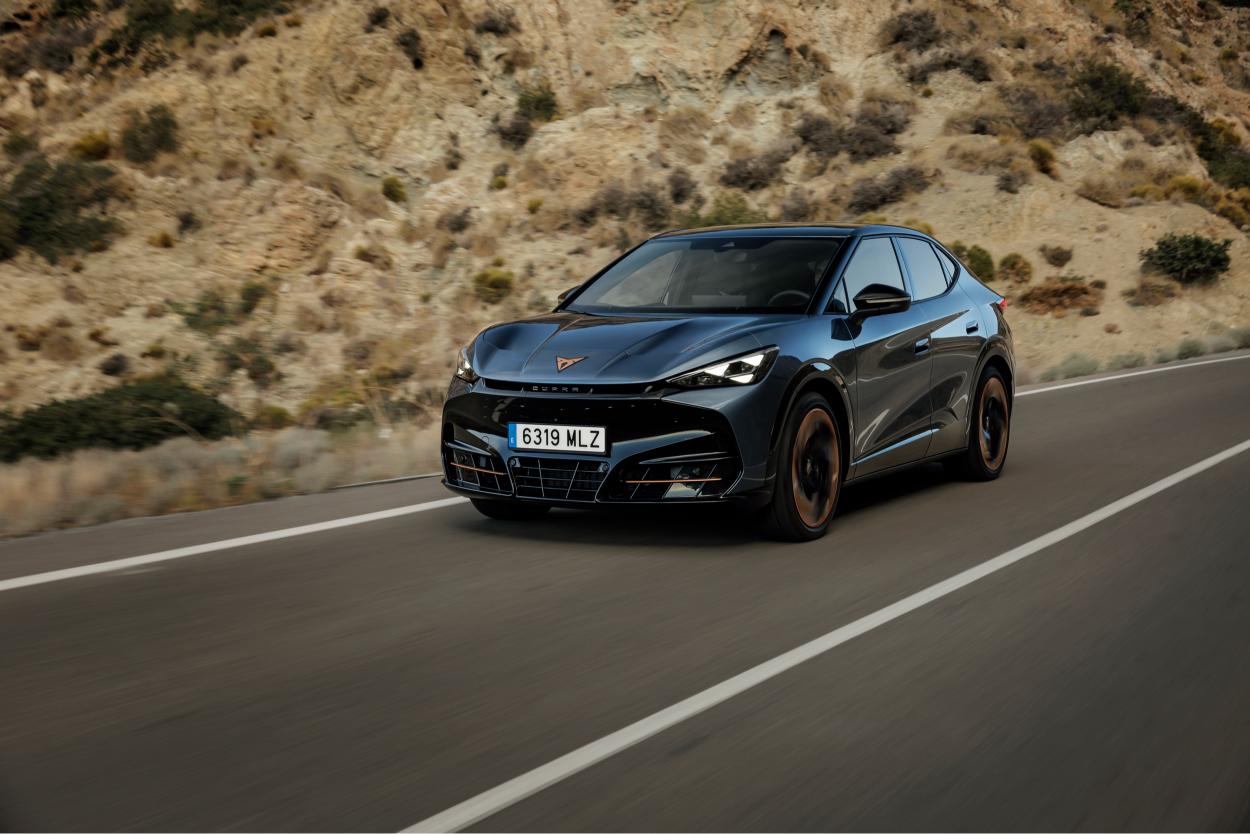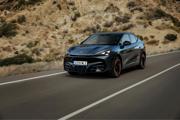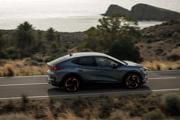Review
Cupra's sleek newcomer takes VW's proven electric vehicle (EV) platform and repackages it as a desirable and engaging to drive family SUV. The Tavascan has competitive running costs, a high specification and decent efficiency.
Overview
Cupra has entered the next stage in its evolution as a standalone brand and now has a fully refreshed line-up, which includes the all-new Tavascan.
It’s based on VW’s MEB platform but Cupra has given the car a unique body and interior. Unsurprisingly, the car’s footprint is very similar to those of the Audi Q4 e-tron, Skoda Enyaq and VW ID 5.
The more rakish Tavascan is the sportiest model of the bunch, with aggressive styling and a more finely tuned chassis. When it comes to VW’s MEB platform, Cupra has good form for turning out quality vehicles. The smaller Born is an excellent all-rounder in the compact segment and the new Tavascan gives the brand a crucial footing in the larger family car segment.
Pricing starts at £47,340 and peaks at £60,835, placing the Tavascan as a rival to cars like the Audi Q4 e-tron, BMW i4, Polestar 2 and Genesis GV60. It may also appeal to drivers who want something more distincitve than a Ford, Hyundai, Kia, Skoda or VW.

Comfort and practicality
With a lower roofline, the Tavascan doesn’t feel as spacious as its VW Group stablemates inside. The interior has been designed to cocoon the driver, for a sportier and more immersive feel.
The curvy ‘T’ shaped dashboard melts into a raised centre console, while the air vents expand into cut outs in the door panels. It’s an impressive aesthetic that’s almost identical to the Tavascan concept car and we’re pleased to report that build quality is top notch too. The materials are high quality and contrast well, especially with the ambient lighting.

In keeping with VW Group’s other MEB-based models, interior switchgear is kept to a minimum which is a little frustrating. The wiper controls are integrated into the indicator stalk and the gear selector sits to the right of the steering wheel.
A flat floor helps to maximise interior space, meaning there’s plenty of legroom for all occupants. There’s enough width to get three adults across the rear bench too, will folds flat for extra loadspace.
Boot volume measures 540 litres and V2 versions, and above, come with a split level boot floor that provides a useful place to store the charging cables.
Safety and technology
As we’ve mentioned already, the Tavascan relies heavily on its central touchscreen in lieu of physical switchgear. The infotainment system uses a new generation of software that puts key functions in easy reach. The climate controls and heated seat buttons are all integrated into a row at the bottom of the display. You can also swipe down from the top of the screen for quick access to some of the driver assistance system settings.
Wireless smartphone connectivity comes as part of the package, too, and V2 models and above get a fantastic Sennheiser sound system.
Where Volkswagen has announced a shift away from haptic switchgear, Cupra has very much stuck with it. The Tavascan’s steering wheel is packed with touch sensitive buttons. We’d say there’s too much going on. There’s plus and minus buttons for both the audio volume and cruise control speed on one side, while up, down, left and right arrows for the instrument cluster display are joined by left and right arrows to change track on the audio system on the right hand side.

Depending on how you hold the steering wheel – a nine and three-o-clock position is not advised – you’ll continually interfere with the outermost controls.
A full suite of driver aids are fitted across the line-up, including adaptive cruise control with travel assist, blind spot monitor, lane assist and reversing camera.
Driveability and range
All Cupra Tavascans use the same 77kWh battery, which can be paired with two powertrain options. The V1 and V2 spec cars come with a single 286PS motor that powers the rear axle.
Go for a VZ1 or VZ2 and you’ll get a second motor on the front axle, giving all-wheel-drive and a combined power output of 340PS.
The single motor cars have plenty of performance on tap, managing 0-62mph in less than seven seconds, while the dual motor cars are more eager and manage the same sprint in just 5.5 seconds.
When it comes to range the single motor cars are the most efficient, offering a WLTP range of 352 miles. This equates to 4.5mi/kWh, which might be a tall order. In mixed driving, in cold weather we were averaging 3.0mi/kWh. We think 4.0mi/kWh is probably achievable, in slightly better conditions, giving a respectable 300-miles range.
Officially, the dual motor car promises 320 miles, but we’d estimate 260 to be a more realistic figure.

Cupra has done an excellent job of setting up the Tavascan’s chassis. It’s planted when you need it to be and playful when you want it to be.
There’s a variety of drive modes including ‘Performance’ and ‘Cupra’ but these only make sense on VZ models, which have adaptive dampers. Here you can tailor the ride for better comfort or a stiffer, more engaging drive.
The V1 and V2 cars, with passive dampers, err on the firm side compared to other MEB-based models.
While the steering is pin sharp, giving a sense of nimbleness, we were a little disappointed by the brake pedal which is initially firm but needs a fair bit of pressure before the car starts scrubbing speed. Stand on the pedal and the brakes are effective, but under light or medium pressure the feel is at odds the rest of the Tavascan’s sporty nature.
Company car tax and running costs
Against premium-badge rivals the Tavascan represents good value at less than £50,000, although you'll probably want one of the £55,000+ VZ models if you're considering the Cupra against the likes of Audi or BMW.
Running costs are competitive, with the Tavascan V1 costing 45ppm over a four-year/80,000-mile cycle. This undercuts cars like the Polestar 2 (47ppm) and puts the Tavascan in a similar financial position to a Kia EV6.
Across the line-up all models sit in the 2% benefit-in-kind tax band, making them highly appealing when compared to petrol, diesel or plug-in hybrid alternatives. Drivers will pay from £20 per month in company car tax.
At any trim level, Cupra has made a heat pump optional. This cruicial feature comes as part of the Winter pack, costing £1,335, pushing the base price of the Tavascan clost to £49,000.
Specs
| Manufacturer | CUPRA |
| Model | Tavascan Estate |
| Specification | CUPRA Tavascan Estate 210kW V1 77kWh 5dr Auto |
| Model Year | 2024.00 |
| Annual VED (Road tax) | £10 |
| BIK List Price | £47,285 |
| Range | 353.00mile(s) |
| CO2 | N/A |
| BIK Percentage | 2% |
| Insurance Group | N/A |
| CC | 1 |
| Fuel Type | Electric |
| Vehicle Type | Medium SUV |
| Luggage capacity (Seats up) | 540litres |
| Doors | 5 |
Running Costs
| P11D | £47,285 |
| Cost per mile | 51.41ppm |
| Residual value | £19,975 |
| Insurance group | N/A |
| Fuel Type | Electric |
| Cost per mile | 168.12ppm |
| Fuel | 2.20ppm |
| Depreciation | 164.15ppm |
| Service maintenance and repair | 1.77ppm |
Rivals
Info at a glance
-
P11D Price
£47,285
-
MPG
N/A (WLTP) -
CO2 Emissions
N/A -
BIK %
2% -
Running cost
3 Year 60k : £19,975 4 Year 80k : £16,125 -
Fuel Type
Electric -
Range
353.00mile(s)

































